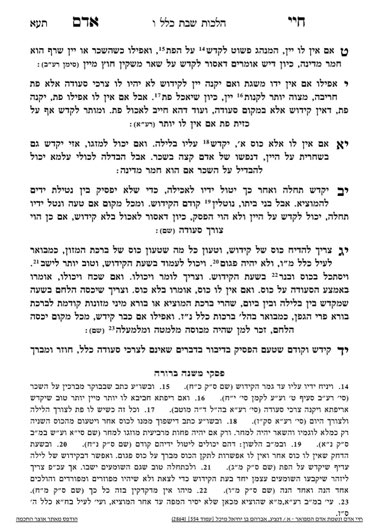The current series, which will cover Maariv on Friday night and Kiddush, is available for sponsorship. Please contact Rabbi Reingold for more information.
We have finished siman 12, where the Chayei Adam writes that he holds that everyone at the seudah should wash before kiddush, besides for the person making kiddush. We learned that some people have the minhag that even the person making kiddush washes beforehand. On the other hand, we know that many people have the minhag to wash after kiddush.
What becomes apparent from the Chayei Adam is that even those who wash after kiddush should wash immediately after kiddush, and should not linger. We see that we are trying to minimize the time gap between kiddush and the seudah, so that would apply to those who wash after kiddush as well. If kiddush is not done at the time of a seudah, one cannot eat and they are not yotzei kiddush either. Thus, those who wash after kiddush should appreciate the importance of minimizing the gap.
When it comes to Sukkos, there can be issues between kiddush and the seuda. If a person’s sukkah is immediately adjacent to their home or built into their home, it is considered going room to room within the house, and it is not considered a shinui makom which would create a hefsek between the kiddush and meal.
However, if a person has to go from outside the sukkah to inside, there is a shinui makom between kiddush and hamotzi, and it removes the halachic status of kiddush b’makom seudah. Thus, even people who do not follow the minhag of the Chayei Adam throughout the year can avoid this issue on Sukkos by following the procedure of the Chayei Adam.
Other options include having everyone drinking a reviis of wine, because according to the Geonim, it counts as kiddush b’makom seudah. Alternatively, one can wash inside the Sukkah or immediately adjacent to it.
Summary
- Kiddush should be bemakom seudah, both in proximity and in time.
- The Chayei Adam holds that everyone should wash before kiddush, besides for the person reciting kiddush.
- Even those who do not follow the minhag of the Chayei Adam should still appreciate the need to minimize the gap between kiddush and hamotzi.
- On Sukkos, if one’s sukkah is not inside or immediately adjacent to their home, they will have an issue leaving the sukkah to wash. They can follow the Chayei Adam’s minhag, have everyone drink a reviis, or wash inside or immediately adjacent to the sukkah.



